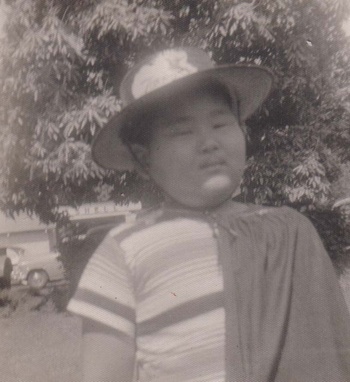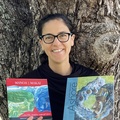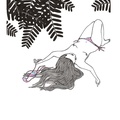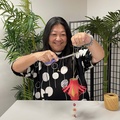
Small kid time Kent Sakoda, 72 wuzn’t known as Kent “Yoda” Sakoda yet. He wuz just one Local Japanese sansei growing up in da small town of Hanapēpē on Kaua‘i. After he wen go graduate from Waimea High School in 1970, he already knew he wanted for leave Kaua‘i for try see what college life on top da continent might be like.
Back den he had no clue he wuz eventually going become one highly respected Pidgin linguist known for his expertise on Hawai‘i Creole, what Locals refer to as Pidgin. He even literally wrote da book on Pidgin. In 2003, him and Jeff Siegel co-authored da ground-breaking textbook Pidgin Grammar: An Introduction to the Creole Language of Hawai‘i from Bess Press.
[Disclosure: I been friends with Kent for half my life and I know he rarely does interviews. Das why I thought for document his accomplishments, maybe I gotta be da one for interview him den.]
* * * * *
I tink you told me before that you reluctant for give interviews cuz you like talk Pidgin, but sometimes hard for make your Pidgin come out?
Yeah, partly. I think because for interviews, it’s like a formal situation thing, so I switch to English more easily. I think I switch to Pidgin more planny when I go back Kaua‘i and I talk to my bruddahs. When you go through this interview, I think you going find more Pidgin than if somebody else wen go interview me because you talking to me in Pidgin.
Fast kine, you can try explain what is Pidgin?
In Hawai‘i, immigrants who came here to work in the sugar plantations, because they came from different countries, they spoke different languages. It was hard for them to communicate so they created what linguists call a lingua franca, which is a common language. So they created this pidgin, with a lowercase p. Then one or two generations later, the children started to use that language as their first language, that's when it became a creole.
So as far as Hawaii goes, most of the original small p pidgin speakers are gone already. But people in Hawai‘i still use the old name, so to differentiate we use uppercase P for Pidgin today, which refers to the creole.
When you wuz growing up, you wuz allowed for talk Pidgin?
Growing up we had to watch how we talk. “No talk Pidgin!” we would be reminded. It wasn’t so much scolding, but teachers would try to correct us. My parents didn’t correct as much as they would warn us. I think they didn’t know how to correct us because they were Pidgin speakers too, right?
So you chose your college cuz dey had one good linguistics program?
No. When I did my undergraduate at Drake University in Iowa, I didn’t know what linguistics was, but there was a requirement to graduate and you either had to take one language course, one speech course, or one linguistics course.
So being Local, speech courses is something that we kinda avoided in those days because you would have to talk in front the class and nobody like talk, you know. And I decided the language class was a harder class to take. That left linguistics and I had absolutely no idea what linguistics was about.
(Laughing) So basically you went into linguistics cuz you nevah like talk and you thought wuz going be mo easy!?
YEAH! (Laughing) But there was a teacher there, Professor Singh. He was from India and the way he presented linguistics was almost magical. He was showing us these grammatical things that we would produce when we talk, but yet you never thought about it in terms of why you do them in that way. I thought that was really amazing. So when I came back to Hawai‘i, I continued my graduate studies in linguistics at UH [The University of Hawai‘i at Mānoa].
But how you came interested in Pidgin kine linguistics?
When I came back, I was one of the few Pidgin-speaking Local students in the department at UH. Meanwhile, a lot of Pidgin stuff was going on so I was always being asked to help.
At UH there was this course, “Pidgin and Creole English in Hawai‘i” that kind of floated between departments. It depended on who was available to teach it. Charlene Sato, who I’m going to refer to as Charlie, was another Local graduate student. After getting her doctorate at UCLA, she came back and took over that course.
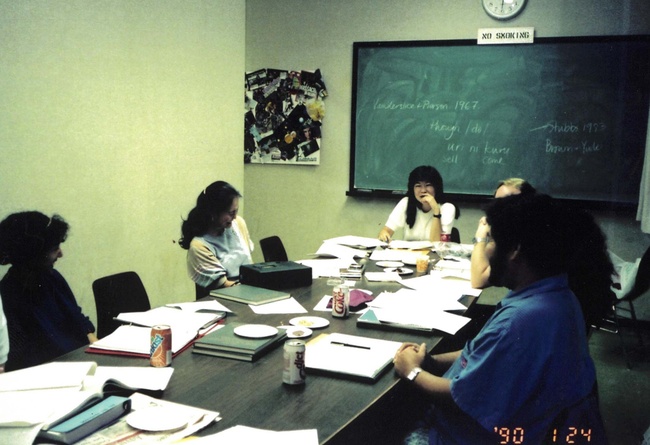
Then in 1992, Charlie offered the course and she had a large number of students who wanted to take the course. So she split it and asked me to teach the other section.
But Charlie passed away in 1996 from cancer. So basically UH asked me if I would take over the Pidgin course. From an infrequent course, it became a more frequent course. I guess they started to see the value of it.
Can you try tell briefly what students learn in your college Pidgin class?
Sure. First they learn about various pidgins and creoles. Then they learn generally how those phenomenon happened. They learn the social history and then they also look at the different linguistic aspects of Pidgin. And then about the use of Pidgin in arts and literature.
You also one of da founders of da Pidgin advocacy group, Da Pidgin Coup. You like try talk about what that?
In 1997, this was after Charlene Sato passed away. Diana Eades came from Australia to take over Charlie’s place at UH. She had already done a lot of advocacy kind of work with Aboriginal English in Australia, so she approached me to see if we could form a group to advocate for Pidgin. So then we got Suzie Jacobs, who was from the English department and Ermile Hargrove, who was an Education Specialist. So it was the four of us who started the group.
Another linguist Jeff Siegel would join the group when he was here because he was kind of going back and forth at that time because he was still teaching in Australia. So we got faculty and students interested from different departments and outside community members, then we wrote our position paper on Pidgin and Education.
So what kine stuff your Pidgin Coup group does?
We used to have these workshops with the DOE [Department of Education] people to teach them about Pidgin like the fact that Pidgin is a language different from English. That kind of thing, right? Because a lot of people think that Pidgin is bad English or broken English. Now that Christina Higgins is the director of the Charlene Sato Center for Pidgin, Creole and Dialect Studies we do other exciting things too like having one Pidgin film festival!
Try talk about how come you decided for come up with your guys’ Pidgin Grammar book.
Initially I was kind of against it. Doing a grammar book. It’s something I think I learned along the way in linguistics. See, there was a lot of other kinds of fieldwork projects in the Pacific area where these linguists would go out and they would collect data and they would write these grammars and dictionaries for these Pacific languages. But anyway, one linguist in particular was telling us years later that he kind of regretted doing it because when you write on grammar and you write a dictionary to a language, it kind of makes the language static Then what he found was that these people, when they're talking about their language or whatever, they will go back to the books. The authority becomes the books and not the people who speak the language. So I had that in mind.
So how come you did 'em den?
My co-author Jeff Siegel as why! He kept bugging me, da guy! He’s internationally renowned. I mean, he’s a very, very big, big name in the pidgins and creoles field. And so I told Jeff how I felt. And he said, “No, no!” He said, “You got to put it down!” Because there was hardly anything, right. So he said we have to set a baseline so we can see how Pidgin might be changing.

At some point, I eventually just said, “Ah, we go do 'em already!” because I realized I had already created a lot of these grammatical handouts for my Pidgin class. So I had a lot of the materials already that we could incorporate into our book. Once I realized that, it made it easier to say okay.
I always kid you that you should’ve wrote your book title in Pidgin. Cuz who going buy one book about grammar, right? BUT if people saw one book called Pidgin Gramma, den dey would grab 'em! Cuz dey would tink must be one book about tūtū [grandma] telling stories. Nah, nah, so how has Pidgin Grammar: An Introduction to the Creole Language of Hawai‘i been received?
Eh, no make [don’t make trouble]! I like our title. I like that people think it’s an oxymoron. They think if you have Pidgin and grammar, it doesn't go together. People are surprised to find out Pidgin does have a complex grammar.
According to the publisher our book does pretty well, it’s used in some college classes. I think I only realized its importance after it came out. See, when Charlie passed away, the discussion we were having was how to treat Pidgin linguistically, because at that time it was still common to treat it like a dialect of English. It was more of a political decision than anything else that we would say that Pidgin is a language. But then once we said that, then we had to kind of prove it. So that's when we had to bring in all the linguistic stuff. And that's when the grammar book became a little bit more important because once we said Pidgin was a language, then we had to show how it was a language like any other language with a grammar and everything, right?
So da person you most grateful to in helping you become Hawai‘i’s foremost Pidgin linguist gotta be Charlene Sato, right?
Probably for getting me into the area. On one personal level, Lee... her passing... wuz quite devastating. (Coming sad) I can still hear her voice inside my head sometimes telling me what for do. I mean, one of da tings she told me when I wen ask her if I should do this Pidgin ting, wuz she said, “You know, Kent, you should do... what... you feel.”
Ho! It’s like she wuz telling you for use da Pidgin force!
Ha! (Coming introspective) Pidgin wuz always one part of me. When somebody talk Pidgin my intuition instantly can tell whether da ting grammatical or not grammatical. I no have to search.
An'den Pidgin became my life actually, right? From da time Charlie wen pass away in 1996, that wuz da year I wen basically take over that course. And das da only course I eva taught my entire life till today!
K, but BRAH, why you always gotta make like YOU know EVERYTING about Pidgin? I still remembah, one time we wuz both teaching our Pidgin classes at Hawai‘i Pacific University, and you just came out da elevator so I wen decide for give you one Pidgin test in front everybody. I wen tell, “Eh Kent, da kine stay da kine, you know.” And you thought for not even two seconds before you said...
Whaaaaat?!? Jolynn pregnant!?
And that wuz correck!! You had no context. I dunno how you knew cuz Jolynn nevah tell nobody. Jolynn no wuz even dea! So when I asked how you wen figgah 'em out, you remembah what you wen tell?
Yoda as why.
© 2024 Lee A. Tonouchi


